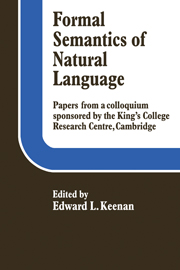Book contents
- Frontmatter
- Contents
- Notes on the contributors
- Acknowledgements
- Introduction
- I QUANTIFICATION IN NATURAL LANGUAGE
- II REFERENCE AND CROSS REFERENCE
- Deixis as the source of reference
- Referential constraints on lexical items
- On generics
- Quantifiers, definite descriptions, and reference
- III INTENSIONAL LOGIC AND SYNTACTIC THEORY
- IV QUESTIONING MODEL THEORETIC SEMANTICS
- V PRAGMATICS AND SENTENCES IN CONTEXT
- VI SEMANTICS AND SURFACE SYNTAX
Referential constraints on lexical items
Published online by Cambridge University Press: 05 November 2011
- Frontmatter
- Contents
- Notes on the contributors
- Acknowledgements
- Introduction
- I QUANTIFICATION IN NATURAL LANGUAGE
- II REFERENCE AND CROSS REFERENCE
- Deixis as the source of reference
- Referential constraints on lexical items
- On generics
- Quantifiers, definite descriptions, and reference
- III INTENSIONAL LOGIC AND SYNTACTIC THEORY
- IV QUESTIONING MODEL THEORETIC SEMANTICS
- V PRAGMATICS AND SENTENCES IN CONTEXT
- VI SEMANTICS AND SURFACE SYNTAX
Summary
The following represents a very provisional report on work going on. The author is fully aware of the fact that there are many uncertainties,unclarities and errors in the text as presented here. Yet it seems that the observations which are made are of a certain interest, and that the ideas put forward deserve some consideration in so far as they indicate a general direction in which an explanatory solution to the problem under consideration might be found.
It is a very widespread phenomenon, in many if not all languages, that verbs are semantically decomposable into a fairly general transitive verb and a generic object. An example from English is brew, which is made up of make and beer, or advise, which is ‘give advice’. Assuming this observation to be correct, we must posit a rule in the grammatical semantics of English, which incorporates the object into a lexical verb. Let us speak of Object-Incorporation. Sometimes, as in the case of brew, the incorporation is optional, since we also have brew beer. Further details could be worked out, such as the fact that an adjective qualifying the object ends up as an adverb: advise someone well, but these are not our concern here.
What does concern us here is the fact that the object which is the object of Object-Incorporation is always a generic NP (or a sortal NP, if you like), but never a referring expression.
- Type
- Chapter
- Information
- Formal Semantics of Natural Language , pp. 84 - 98Publisher: Cambridge University PressPrint publication year: 1975
- 1
- Cited by

